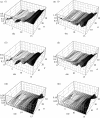Connectivity sustains disease transmission in environments with low potential for endemicity: modelling schistosomiasis with hydrologic and social connectivities
- PMID: 18782722
- PMCID: PMC2575370
- DOI: 10.1098/rsif.2008.0265
Connectivity sustains disease transmission in environments with low potential for endemicity: modelling schistosomiasis with hydrologic and social connectivities
Abstract
Social interaction and physical interconnections between populations can influence the spread of parasites. The role that these pathways play in sustaining the transmission of parasitic diseases is unclear, although increasingly realistic metapopulation models are being used to study how diseases persist in connected environments. We use a mathematical model of schistosomiasis transmission for a distributed set of heterogeneous villages to show that the transport of parasites via social (host movement) and environmental (parasite larvae movement) pathways has consequences for parasite control, spread and persistence. We find that transmission can be sustained regionally throughout a group of connected villages even when individual village conditions appear not to support endemicity. Optimum transmission is determined by an interplay between different transport pathways, and not necessarily by those that are the most dispersive (e.g. disperse social contacts may not be optimal for transmission). We show that the traditional targeting of villages with high infection, without regard to village interconnections, may not lead to optimum control. These findings have major implications for effective disease control, which needs to go beyond considering local variations in disease intensity, to also consider the degree to which populations are interconnected.
Figures






Similar articles
-
Heterogeneity in schistosomiasis transmission dynamics.J Theor Biol. 2017 Nov 7;432:87-99. doi: 10.1016/j.jtbi.2017.08.015. Epub 2017 Aug 17. J Theor Biol. 2017. PMID: 28823529 Free PMC article.
-
Refined stratified-worm-burden models that incorporate specific biological features of human and snail hosts provide better estimates of Schistosoma diagnosis, transmission, and control.Parasit Vectors. 2016 Aug 4;9(1):428. doi: 10.1186/s13071-016-1681-4. Parasit Vectors. 2016. PMID: 27492409 Free PMC article.
-
Analysis of the effectiveness of control measures against Schistosoma mekongi using an intra- and inter-village model in Champasak Province, Lao PDR.Parasitol Int. 2011 Dec;60(4):452-9. doi: 10.1016/j.parint.2011.07.017. Epub 2011 Jul 28. Parasitol Int. 2011. PMID: 21820079
-
A review of the biology and transmission ecology of African bovine species of the genus Schistosoma.Z Parasitenkd. 1983;69(5):551-70. doi: 10.1007/BF00926667. Z Parasitenkd. 1983. PMID: 6356670 Review.
-
Modelling environmentally-mediated infectious diseases of humans: transmission dynamics of schistosomiasis in China.Adv Exp Med Biol. 2010;673:79-98. doi: 10.1007/978-1-4419-6064-1_6. Adv Exp Med Biol. 2010. PMID: 20632531 Free PMC article. Review.
Cited by
-
Toward sustainable and comprehensive control of schistosomiasis in China: lessons from Sichuan.PLoS Negl Trop Dis. 2011 Oct;5(10):e1372. doi: 10.1371/journal.pntd.0001372. Epub 2011 Oct 25. PLoS Negl Trop Dis. 2011. PMID: 22039563 Free PMC article.
-
Commentary by Spear, R. on "Integration of water, sanitation, and hygiene for the prevention and control of neglected tropical diseases: a rationale for inter-sectoral collaboration:" can the control of NTDs profit from a good WASH?PLoS Negl Trop Dis. 2013 Sep 26;7(9):e2473. doi: 10.1371/journal.pntd.0002473. eCollection 2013. PLoS Negl Trop Dis. 2013. PMID: 24086791 Free PMC article. No abstract available.
-
Coexistence of nestedness and modularity in host-pathogen infection networks.Nat Ecol Evol. 2020 Apr;4(4):568-577. doi: 10.1038/s41559-020-1130-9. Epub 2020 Mar 9. Nat Ecol Evol. 2020. PMID: 32152533
-
Connecting network properties of rapidly disseminating epizoonotics.PLoS One. 2012;7(6):e39778. doi: 10.1371/journal.pone.0039778. Epub 2012 Jun 25. PLoS One. 2012. PMID: 22761900 Free PMC article.
-
Estimating the elimination feasibility in the 'end game' of control efforts for parasites subjected to regular mass drug administration: Methods and their application to schistosomiasis.PLoS Negl Trop Dis. 2018 Nov 12;12(11):e0006794. doi: 10.1371/journal.pntd.0006794. eCollection 2018 Nov. PLoS Negl Trop Dis. 2018. PMID: 30418968 Free PMC article.
References
-
- Anderson R.M., May R.M. Oxford University Press; New York, NY: 1991. Infectious diseases of humans: dynamics and control.
-
- Appleton C.C., Ngxongo S.M., Braack L.E., le Sueur D. Schistosoma mansoni in migrants entering South Africa from Mocambique—a threat to public health in north-eastern KwaZulu-Natal? S. Afr. Med. J. 1996;86:350–353. - PubMed
-
- Barbera J., Macintyre A., Gostin L., Inglesby T., O'Toole T., DeAtley C., Tonat K., Layton M. Large-scale quarantine following biological terrorism in the United States—scientific examination, logistic and legal limits, and possible consequences. J. Am. Med. Assoc. 2001;286:2711–2717. doi: 10.1001/jama.286.21.2711. - DOI - PubMed
Publication types
MeSH terms
Substances
Grants and funding
LinkOut - more resources
Full Text Sources
Medical

